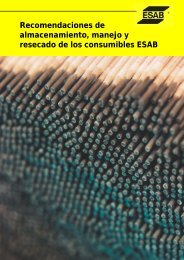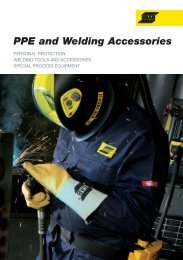You also want an ePaper? Increase the reach of your titles
YUMPU automatically turns print PDFs into web optimized ePapers that Google loves.
For thicker sections, of 10mm and above,<br />
preheating to 100°C can ease the welding<br />
process, reduce residual stresses and slow down<br />
the cooling rate, especially in the root pass.<br />
Typical recommendations for interpass<br />
temperatures are maximum 200-250°C for duplex<br />
and lean duplex grades whereas maximum 150°C<br />
(or lower) should be used when welding<br />
superduplex steels.<br />
CRONIGON ® 2<br />
(Ar + 2.5% CO 2<br />
)<br />
CRONIGON ® S3<br />
(Ar + 3% O 2<br />
)<br />
CRONIGON ® 2He20<br />
(Ar + 2% CO 2 + 20% He)<br />
3. Shielding gases for MIG welding<br />
Generally, the same shielding gases are used for<br />
welding duplex steel as for austenitic steels, see<br />
Table 4. MIG welding under pure argon shielding<br />
is now rarely used, since the arc is unsteady and<br />
the penetration is poor. Active gas mixtures<br />
consisting of argon and additions of oxygen or<br />
carbon dioxide are generally applied. In<br />
comparison to the gases used for welding of<br />
unalloyed steel, the content of active gases is<br />
lower. Argon-oxygen gas mixtures (most common<br />
percentage of oxygen is between 1 and 3%)<br />
produce very stable electric arc and spatter-free<br />
processes. In comparison to the Ar/CO 2<br />
mixtures,<br />
the penetration profile is less favourable and the<br />
weld surface is more oxidised. The penetration<br />
depth might be increased by applying higher<br />
oxygen content, but then oxidation of the joint<br />
surface is even stronger. Also, losses in<br />
toughness and ductility have been reported.<br />
Because of this, Ar/CO 2<br />
gas mixtures with a CO 2<br />
content of 2-3% are widely used. These gases<br />
provide better penetration with lower oxidisation,<br />
Figure 4.<br />
Further improvement can be achieved by adding<br />
helium to the gas mixture. Compared to argon,<br />
helium has higher thermal conductivity and higher<br />
ionisation potential. This leads to better wetting<br />
capabilities and higher travel speeds. Another effect<br />
that can be observed with the helium-bearing<br />
shielding gases is that they seem to cause a more<br />
Table 4. Shielding gases for MAG welding of duplex steels.<br />
Name EN439 AWS A5.32 Composition in vol. %<br />
Figure 4. Influences of shielding gases on weld surface and penetration profile on stainless steel. Results on duplex<br />
are comparable. Mechanised MAG welding, wire feed speed 9 m/min, plate thickness 10 mm.<br />
even distribution of oxides on the weld surface,<br />
Figure 4. Whereas, in the first two samples, the<br />
oxides appear to form ’islands’ on the weld<br />
surface, the surface of the third sample appears<br />
less heavily oxidised, which helps cleaning the<br />
weld afterwards.<br />
4. Shielding gases for TIG welding<br />
Compared to the MAG process, heat input in TIG<br />
welding is controllable in a wider range. However,<br />
the rules regarding linear energy input and cooling<br />
rate are also valid here.<br />
The standard shielding gas for TIG welding of<br />
duplex steels is pure argon. With this gas, the<br />
majority of welding jobs are performed safely and<br />
cost-effectively. Argon/hydrogen mixtures that are<br />
frequently used for welding of austentic steels, with<br />
the intention of increasing welding speed, are not<br />
recommended because, under certain<br />
circumstances, hydrogen-induced cracking may<br />
appear due to the high ferrite content in the material.<br />
Argon/helium mixtures offer increased heat input -<br />
particularly advantageous for the duplex steels -<br />
which has a favourable effect on the viscosity of<br />
the base material and provides a wider range of<br />
acceptable welding parameters. Arc voltage and<br />
linear energy input is also increased with<br />
increased helium content. An overview of<br />
Ar He O 2<br />
CO 2<br />
CRONIGON ® 2 M12 SG-AC-2.5 Bal. - - 2.5<br />
CRONIGON ® 2 He 20 M12 (1) SG-AHeC-20/2<br />
Bal. 20 - 2<br />
CRONIGON ® 2 He 50 M12 (2) SG-AHeC-50/2 Bal. 50 - 2<br />
shielding gases used for TIG welding of duplex<br />
steels is given in Table 5. Duplex steels are TIG<br />
welded applying filler material in most cases.<br />
Duplex filler material usually contains a slightly<br />
higher percentage of Ni than the base material. In<br />
contrast to the MAG process, in certain cases<br />
use of filler material may be avoided, for example<br />
in orbital welding of tubes. The advantage in such<br />
cases is that welding speed may be increased if<br />
filler material is not applied. This leads to shorter<br />
welding time, resulting in cost reduction. This<br />
welding technique is possible through the use of<br />
nitrogen-containing shielding gases. While in<br />
non-autogenous welding, the increased content<br />
of nickel in the filler material provides a balanced<br />
ferrite/austenite ratio, in autogenous welding this<br />
task is taken by the nitrogen in the shielding gas.<br />
Nitrogen is a strong austenite-promoting element<br />
and, as a shielding gas component, can help<br />
achieve well-balanced austenite-ferrite-ratios. In<br />
any case, it should be noted that tungsten tip wear<br />
is more intensive because of nitrogen content, ie,<br />
the electrode needs to be re-ground more<br />
frequently than if welding in pure argon shield.<br />
5. Examples of application<br />
As an example, N-containing shielding gases<br />
have already been used in orbital TIG welding of<br />
tubes made from a 22%Cr grade 1.4462 duplex<br />
steel, Figure 5. The wall thickness of the tube was<br />
2 mm, outer diameter was 54 mm. Welding<br />
without filler material has been applied. Measuring<br />
of the ferrite content in the weld metal was not<br />
made through metallographic examination, but<br />
with a magneto-inductive method. The values of<br />
mean ferrite content should only be taken as<br />
trend indicators.<br />
44 - <strong>Svetsaren</strong> no. 1 - <strong>2007</strong>




